by Kathy Scarbrough
Just when it looks like some progress is being made against transgender ideology infringement on women’s hard won rights—at least in the UK and in Spain—we were alarmed to learn of the inroads it is making in public schools in the U.S.
Children as young as kindergarten are being schooled in gender ideology, and sometimes encouraged to choose an identity, even before they are old enough to understand what it’s all about. Schools don’t usually teach sex education to young elementary school children, but they seem to have no such qualms about “gender education.” We do not know how widespread this practice is, but corporate book publishers, ever ready to fill their coffers, offer an array of books for elementary schools to choose from, as amazon.com reveals.
Two years ago there was an opinion piece in the Washington Post decrying the California guidelines for teaching gender identity to Kindergarteners:
It makes sense to tell children that daddy can be a nurse and mommy can be a lawyer. But for some reason, I doubt they’ll understand that daddy can fall anywhere on an ever-expanding gender-identity spectrum. Nor can parents choose to remove their children from this indoctrination. While parents can opt their children out of lessons on sexual health that involve discussions of sexual organs and their functions, they are forbidden from removing their children from any discussion of gender identity.
We learned recently that a group called Biology Matters used public disclosure laws to obtain detailed information from the Seattle public schools on their teaching about transgenderism. Biology Matters was created by a couple of grandparents who became concerned about what is being taught to kids in schools under the guise of “inclusion.” They’ve made a very good video on the books being used in Seattle and a follow up video that takes on sex education and the effect of transgender ideology on same sex attraction, as well as other topics. In what follows, I’ve excerpted some of Biology Matters comments on the more outrageous things in these books, but you are encouraged to watch the videos in their entirety. Importantly, the criticism offered by Biology Matters is not from a conservative position; this is how they express their viewpoint:
We, the makers of this video, are on the “left” end of the political spectrum. We strongly support sex education and gay rights. We strenuously fight sexist stereotypes and gender oppression. We support civil and human rights for all, including trans-identifying people.
Biology Matters discovered that trans affirming teaching starts in Kindergarten, one book that might be read to children is Introducing Teddy by Jessica Walton published by Bloombury USA Childrens:
Introducing Teddy features a Teddy Bear named Thomas, who tells his human friend Erroll, “In my heart, I’ve always known that I’m a girl teddy, not a boy teddy. I wish my name was Tilly, not Thomas.” Errol immediately starts calling the bear, “Tilly” and using the pronoun “she” instead of “he.” This makes the bear happy.
The teddy bear, who, like most teddies is naked, has no sexual characteristics whatsoever. Who could possibly object to calling it a girl as opposed to a boy?
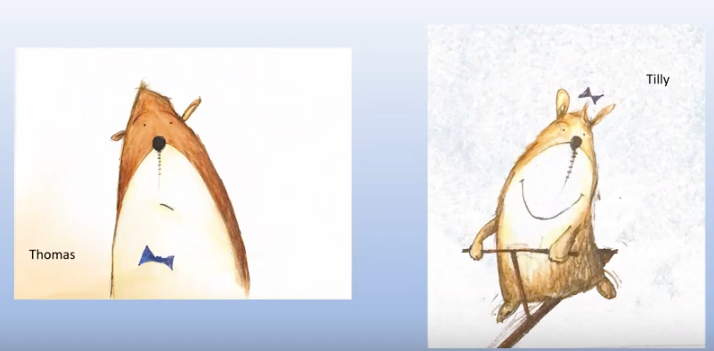
Introducing Teddy also delivers a subtle sexist message. “I’ve always wanted a bow” instead of a bow tie,” Tilly says. Kindergarteners will wonder why the teddy bear didn’t put the bow on its head when he was Thomas. The answer they will likely come away with is this: if you want to wear a bow in your hair, you’ve got to be a girl.
***
In the first and second grades children might be read A House for Everyone by Jo Hirst.
[The book defines the term] “gender identity” – “how you feel inside about whether you are a boy or a girl, or something else.” This is a definition that misleads children into believing there are more than 2 sexes.
The whole idea of an innate gender identity is scientifically controversial, it suggests that there are girl brains and boy brains and what your brain “thinks” of your identity may, or may not, correlate with the reproductive system you were born with. I am a scientist who for many years studied how brain drives the pituitary gland which drives the reproductive system and I am among those who consider this theory of “brain sex” wrongheaded. Many papers and even whole books have been written discussing the scientific evidence for the idea of meaningful differences in the brains of females and males, and many authors find the data lacking. But here this theory of gender identity is presented to young children as if it is settled knowledge—like the germ theory or the theory of evolution. Biology Matters continues:
The lesson plan [for use with this book] teaches children that everything they do is a statement, an expression. If a child puts on clothes for the day, they’re not just putting on clothes. They’re expressing something. If they do cartwheels, they’re expressing something. And these are not just personality expressions. They’re “gender” expressions. Children are asked to fill in information about each character in the book in a chart like this:
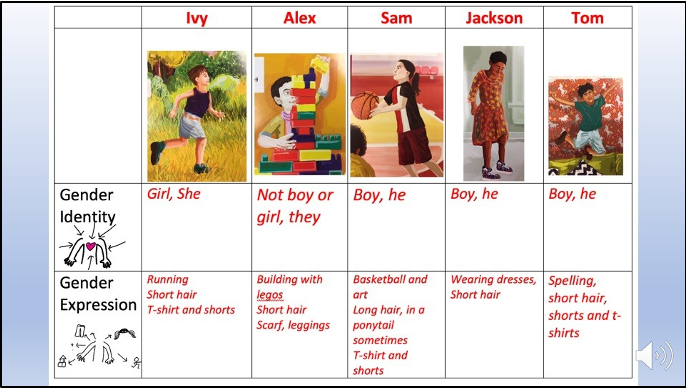
Are there things each character can do that are NOT considered GENDER expressions? Evidently not. Note that there is no row in the chart for “sex”.
We don’t often use the word sex with first to third graders, but most children know there is a difference in genitals between boys and girls even without knowing the word for those differences. The perceptive child might wonder if those children who don’t “feel” like either a boy or a girl have any genitals at all. While these sex differences aren’t important at this age, gender ideology makes children choose. If instead we promoted the correct idea that there is a continuum of human behavior that does not correlate with sex, we wouldn’t need the concept of multiple genders or need to choose one.
If, as this book purports, boy and girl have nothing to do with sex, and we accept the progressive message that some girls like to run and have short hair and some boys might like to try wearing dresses, how do we determine who is a girl and who is a boy? What was it that made “Tom”, who was born female, decide to “be” a boy? Could sexist statements that start with “girls can’t do …” have influenced “Tom”? My daughter was told such things by other children in preschool. When my son was 3 years old, he was told that he wasn’t wearing “boys” clothes by other 3-year-old boys. Gender policing starts at a very tender age. These books are heavy handed in reinforcing gender rather than emphasizing the commonalities between the interests of girls and boys. Conventional “girl” or “boy” behavior doesn’t fit many people. Why not simply conclude that the culturally defined categories—“feminine” and “masculine”—are the problem? And while we are at it, why not ask who benefits from the perpetuation of notions of masculinity and femininity?
***
The book They She He Me, Free To Be! also geared toward first or second graders, introduces something central to gender ideology: pronouns.
Children are urged to come up with their own pronouns, which can include words like she/he, they, ze, even Tree! You can tell people that your pronoun is your name! There’s no end to the fun children can have focusing on what their pronouns should be
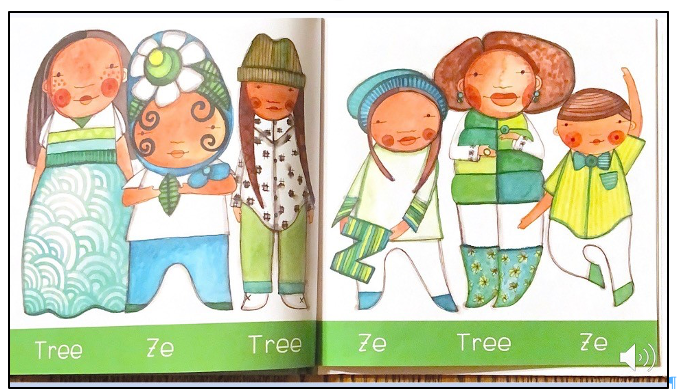
***
The Gender Identity book for 3rd grade, Is That for A Boy or a Girl?, starts out well. … it takes on the important topic of sexist stereotypes and shows how senseless and unjust they can be.
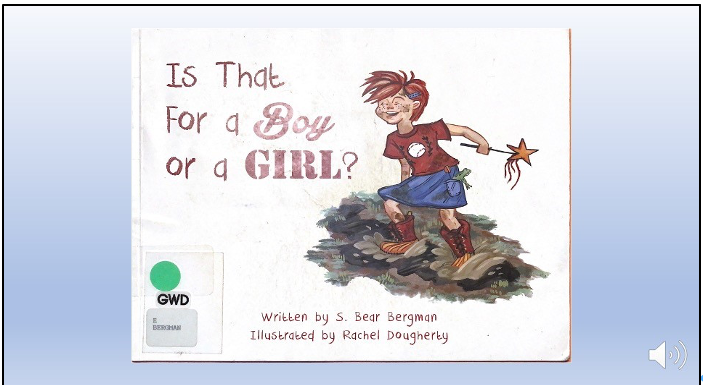
[But later we] meet a child who is upset at being asked to use the bathroom corresponding to their biological sex because they believe themselves to be the opposite sex. … [This book] makes it clear that a person’s self-perception must be treated as reality, even when doing so affects the rights of others. In this case: the rights of people to have sex-segregated private spaces like bathrooms and locker rooms.
***
A book called It Feels Good to be Yourself by Theresa Thorn and Noah Grigni, published by Henry Holt for 3rd, 4th or 5th Graders, introduces more of the vocabulary of gender ideology.
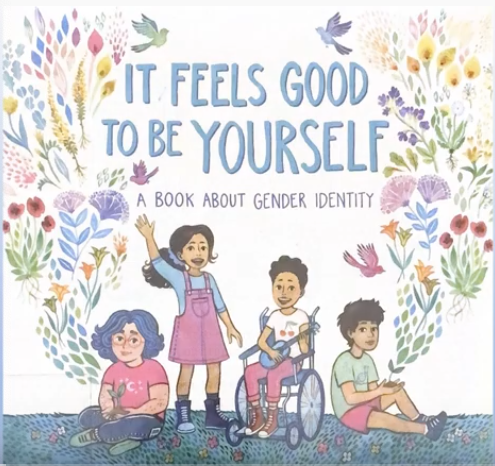
School children are introduced to Ruthie, who is, “a transgender girl. That means when she was born, everyone thought she was a boy. Until she grew a little older—old enough to tell everyone that she’s actually a girl.” … Xavier is Ruthie’s brother. He is labeled “a cisgender boy”. This means he doesn’t deny that he is a boy.
The book then introduces Ruthie’s friend, Alex, who is said to be both a boy and a girl. (Again, just to be clear. Alex is a girl. Her sex remains constant even as her thinking changes.)
And there’s Alex’s friend JJ, who, “is NEITHER A BOY NOR A GIRL.”
Alex and JJ, the book explains, are both NON-BINARY. It explains that some kids feel that their gender identity isn’t always the same; it changes with time.
At first it might seem that being a girl or a boy is completely independent of your sex. But then we have the helpful definition that being “a cisgender boy” means you don’t deny that you are a boy. So, sex is lurking the background, unspoken. Is claiming a quasi-religious belief that you are the opposite sex, or both boy and girl, or neither girl nor boy, the best way we can think of to fight sexist stereotypes? Do we need to promote the pseudoscientific notion that some people can be “both” or “neither” sex? Yes, intersex people are a very small minority of the human population but that is not what is being taught here. The book’s authors also helpfully add,
You might feel that none of these words describes you perfectly. You might not be sure yet. Maybe you’re still figuring it out.”
Biology Matters replies:
The clear implication of these statements is that figuring out your gender identity is a valuable use of time and energy. And how do you determine what your gender identity is? From the murky reasoning presented in the book, apparently what you like to wear and do, has something to do with it.
[…] Lesson plans tell teachers to read the book twice, and during the second reading to have children fill in slips of paper for each character. “When I was born I was assigned ____at birth.” “As I grew older, I realized that I am _____ .” “When people talk about me, they should use the pronouns ______.”
The children are then made to produce “gender identity maps” for each character, and spend time discussing those maps. While schools aren’t allowed to teach astrology, and they don’t have children map out their astrological signs or analyze how star alignment will shape their futures, they do require children to learn gender identity terminology, which has no more basis in science.
Then comes a particularly twisted ploy: The book asks, “It feels good to be YOURSELF, doesn’t it?” But children who embrace “gender identities” that don’t fit with their biology are literally disassociating from their bodies. They are treating a big part of themselves – their actual physical bodies – as something to be ignored, denounced, or even chemically and surgically altered. According to the book, rejecting your body is synonymous with feeling good to be YOURSELF!
There is also an emphasis in the lesson on teaching children that good people and good families always go along with whatever children say about their sex. When children reject their sex, when they seek to “transition” to another sex, the only loving option for families is to say is, “That’s great!”, or so children are led to believe.
***
I Am Jazz, brought to you by Dial books, is aimed at 4th graders and this book brings in the final elements of gender ideology propaganda. Using the story of a real person, first it makes the scientifically controversial mind-body aspect explicit, “I have a girl brain in a boy body”, explains Jazz. Then it introduces the sports controversy.
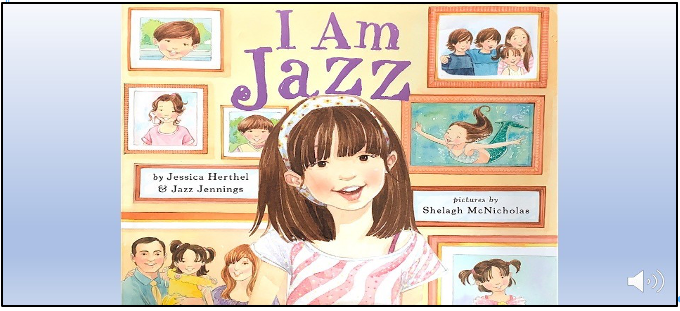
Jazz is initially required to do sports with the boys and Jazz is very unhappy. Ultimately Jazz is allowed on the girls team. Who would object to a pre-pubertal child who wants to be accepted as a girl playing on the girls team?
Notice what the reference to Jazz’s sports activities in elementary school accomplishes. It subtly conveys that males in female sports is a great and liberating thing. Meanwhile, it renders invisible the feelings and concerns of those who don’t like the idea.
Many feminists like the idea of mixed sports, especially at these young ages. Indeed, rather than dividing leagues by sex a better approach might be to have “gentler” and “more aggressive” divisions. Not all boys do well in an aggressive game and not all girls need be placed in “gentler” leagues. But with development come differences between the sexes in bone density, muscle mass and size, and the situation changes. Some sports may lend themselves to continued integration whereas others do not.
Biology Matters also makes this important point:
Jazz is presented to school children as the picture of health and self-realization.
Completely missing from school materials is any mention of the harrowing realities of Jazz’s medical transition, including complications and extreme pain associated with removing his penis. Problems like infertility, disruption of brain development, bone density loss, the inability to have orgasms, and increased risk of heart attacks and strokes aren’t mentioned. The stories of those who desist and detransition from trans identities are never shared.
***
What can those of us who see the sexism in gender ideology do? We could find out if gender ideology is being taught in our local schools and raise the issue with them. Conservative Christians are not the only people who believe sexual differentiation is real. Recently conservatives have waged angry protests at Boards of Education on both gender ideology and Critical Race Theory. We must make it explicit that those of us protesting gender identity education are standing for teaching the truth about sex whereas those protesting the teaching about race are standing against truth—against teaching the truth of our U.S. history.
We could demand that books like Sex and Gender: An Introductory Guide by Phoebe Rose, be included in the curriculum. This book is geared toward middle school students and takes on the difference between sex and gender identity directly. At the same time its message is very supportive of breaking stereotyping based on sex.
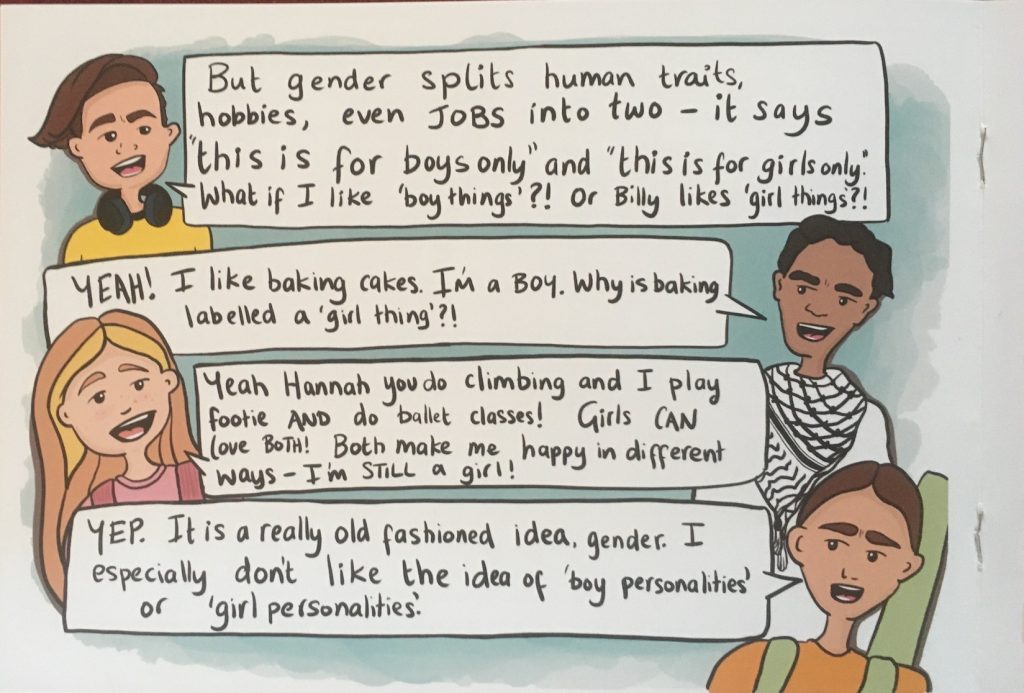
There are several books written for younger children emphasizing the message that you need not deny being a girl or boy because of the things you like to play with. In particular there seems to be a focus on boys breaking gender norms (see for example here and here and here). The customer reviews of these books are quite interesting; they go from one extreme to the other and include everything in between. None that I saw raised the idea that maybe we don’t really want to support fairy princesses anymore, but I did see one comment about how women had to struggle to be allowed to wear pants. If you know of other books that should be used in these school curricula, particularly for kindergarten and young elementary students, please enter the titles and authors in the comment section below this post.
A small action that might be useful is to leave a critical review from a feminist perspective, of books promoting transgender ideology on Amazon. Right now most of these books have hundreds of positive reviews, indeed there are so many positive reviews it looks like the result of transactivist organizing.
Another thing, of course, is to talk to the young people in your life and emphasize that you don’t need to change your body to match current sex stereotypes. It seems laughable but in the 21st century, it is a political statement to say that its OK for girls to be rough and tumble and for boys to like the color pink!
***
Just got this excellent essay with a direct warning about the cost of embracing sex denialism to those on the Left.
***
We’d love to hear your comments and any other action ideas you may have. If you have trouble posting them, please send them to MeetingGroundOnLine@verizon.net with a note to post it and we can do it for you.

This came from Amanda Martins in Brazil,
[T]he approach was also great, always showing the main focus of the radical feminist’s criticisms towards gender ideology: it supports the status quo while rebranding the sex-based oppression into an identity party that anyone can play with sexist and regressive stereotypes. In that view, it’s impossible to identify the oppression, the oppressors and the oppressed.
Reading this article made me think seriously if I was born recently… How would I identify myself? I was never a typical “feminine” girl but I loved my dolls. I also loved video-games and cars. It’s very contradictory how they claim that things like clothes and colors have no gender and yet, they still appeal to the sexist division of our clothes, colors, personalities, behaviors, etc to classify someone as “(cis) women”, “non-binary”, etc.
Thank you for this timely article. The school where I worked recently began instituting first anti-racist elements into the curriculum after several trainings of teachers and staff. I welcomed this at first as it is an important topic. It quickly degenerated into trendy catch phrases and divided the faculty into those that were ‘on board,’ those that had questions and those who were against it. This lead to the introduction of identity politics, which took on the form of gender identity. I felt that it was something to discuss with each other, as adults, or with alumni that had gone on to high school and college. This was not well received and I found myself working at a school whose philosophy I no longer recognized. Children, as early as first grade, were being asked which pronouns they wanted to use, before they were taught what pronouns were. At present, parents are now counseled that the use of ‘puberty blockers’ is okay if there is confusion in gender identity. I am all for the idea of teaching in a non-binary way where activities and such have no gender so that each child can follow where their interests and talents lead them. However, as the article points out, it is just as sexist to push children to focus on their outward appearance, self-identification and roles at too-young an age as it has been to push them into traditional roles.